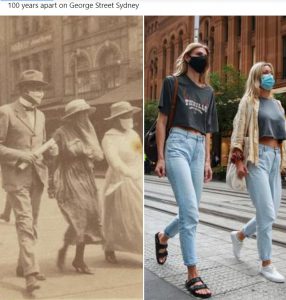In 1918-1919, when the Spanish influenza pandemic swept the globe, Australians – with their peculiar sense of humour – devised unique ways of dealing with the apparatus and cures popular at the time. For example, hideous faces were painted onto the face mask, or kewpie dolls and huge wire spiders hung from the sides.
However, ladies of fashion used the masks as fashion accessories and rather than the small cheesecloth styles that were in general use, the fashionable ladies wore flowing gossamer veils – much like a Yashmak – with only their eyes visible.
The masks came in every shape and size: there were narrow masks, flat masks and even curved masks. Moustaches even went out of fashion for a time because the masks were uncomfortable in hot weather. Even the dogs obeyed the rules.
There was a DIY suggestion – with a hole for a cigarette but, since it was illegal to exhale outside of the mask, you had to swallow the resulting smoke.
Australians were eager to follow the mask guidelines and newspapers published guides on how to make your own. Such was the run on mask-making cloth, the Commonwealth had to fix a price to stop rampant profiteering.
In 1919 Popular Science disagreed with laws that mandated the wearing of flu masks. There were big debates about the efficacy of masks. One doctor proclaiming masks were “as useful as a barbed-wire fence for keeping out the flies”.
The Herald (Melbourne), 1 February 1919 published the following article: What kind of mask should be worn? This is a question that has been puzzling many people. Some have been wearing thin gauze without folding it into several layers, and such have been characterised as worse than useless.
The perfect mask is indicated by a recommendation of the Medical Advisory Committee as follows: Masks effectively made and properly worn afford a great but not absolute protection against the disease. As the infection may be acquired through the duct leading from the eye to the nose cavity, an efficient mask connotes the covering of the eye. The covering material should be equivalent to six layers of ordinary butter gauze.
This is another extract from Trish Skehan’s latest book, Frontline of the Pandemic. Australia 1919. This book can be purchased from the City of Canada Bay Museum. Cost $20 + postage.










